Biology:Wild horse
| Wild horse | |
|---|---|
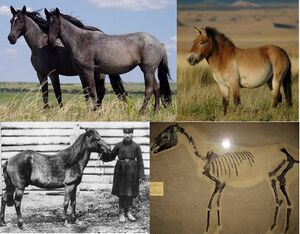
| |
| Top left: Equus ferus caballus (horses) Top right: Equus ferus przewalskii (Przewalski's horse) Below left: Equus ferus ferus† (tarpan) | |
| Scientific classification | |
| Script error: No such module "Taxobox ranks".: | Animalia |
| Script error: No such module "Taxobox ranks".: | Chordata |
| Script error: No such module "Taxobox ranks".: | Mammalia |
| Script error: No such module "Taxobox ranks".: | Perissodactyla |
| Script error: No such module "Taxobox ranks".: | Equidae |
| Script error: No such module "Taxobox ranks".: | Equus |
| Script error: No such module "Taxobox ranks".: | Equus |
| Script error: No such module "Taxobox ranks".: | <div style="display:inline" class="script error: no such module "taxobox ranks".">E. ferus |
| Binomial name | |
| Equus ferus Boddaert, 1785
| |
| Subspecies | |
| |
The wild horse (Equus ferus) is a species of the genus Equus, which includes as subspecies the modern domesticated horse (Equus ferus caballus) as well as the endangered Przewalski's horse (Equus ferus przewalskii, sometimes treated as a separate species i.e. Equus przewalskii).[2][3] The European wild horse, also known as the tarpan, that went extinct in the late 19th or early 20th century has previously been treated as the nominate subspecies of wild horse, Equus ferus ferus, but more recent studies have cast doubt on whether tarpans were truly wild or if they actually were feral horses or hybrids.[4][5][6]
Other subspecies of Equus ferus may have existed and could have been the stock from which domesticated horses are descended.[7] Przewalski's horse had reached the brink of extinction, but was reintroduced successfully into the wild.[8] The tarpan became extinct in the 19th century, but is theorized to have been present on the steppes of Eurasia at the time of domestication.[9][10][11][12] Since the extinction of the tarpan, attempts have been made to reconstruct its phenotype using domestic horses, resulting in horse breeds such as the Heck horse.[13][14] However, the genetic makeup and foundation bloodstock of those breeds is substantially derived from domesticated horses, so these breeds possess domesticated traits.
The term "wild horse" is also used colloquially in reference to free-roaming herds of feral horses; for example, the mustang in the United States,[15] and the brumby in Australia.[16] These feral horses are untamed members of the domestic horse (Equus caballus), not to be confused with the truly "wild" horse subspecies extant into modern times.
Distribution
Evidence supports E. ferus as having evolved in North America about 1.1 - 1.2 million years ago. Around 800,000 - 900,000 years ago, E. ferus migrated west to Eurasia via the Bering Land Bridge, and south to South America via the Isthmus of Panama as part of the Great American Interchange. By the mid-late Pleistocene, it had an extremely large range across the Americas, Eurasia, and North Africa, across which it was abundant. There have been several fossil horse taxa from throughout this range, such as Equus lambei and Amerhippus, that were formerly considered distinct species, but genetic and morphological analysis supports them as being conspecific with E. ferus.[17][18][19][20]
By the latest Pleistocene or early Holocene, American populations had disappeared as part of the Quaternary extinction event, leaving only the Old World populations. It remained widespread there and was ultimately also domesticated around 3600 B.C., but wild populations continued to decline. The last completely wild populations of the tarpan went extinct in Eastern Europe and the southern parts of Russia around the late 19th century, and Przewalski's horse of Central Asia became extinct in the wild in 1969. However, over the past few centuries feral horses have been introduced to all continents except Antarctica, and Przewalski's horses have been reintroduced to their former habitats in Mongolia.[17]
Ecology
In general, wild horses are grazers that prefer to inhabit open areas, such as steppes and grasslands. They may have seasonal food preferences, as seen in the Przewalski's subspecies.[21] Horses may fall prey to native predators including wolves,[22] cougars,[23] and spotted hyenas.[24]
Subspecies and their history
E. ferus has had several subspecies, those of which survived into modern times are:[25]
- The domesticated horse (Equus ferus caballus).
- The Eurasian wild horse (Equus ferus ferus), incorrectly listed as Equus caballus ferus in MSW 3; originally considered synonymous with the tarpan, though recent research has cast doubt on this. Horses identified as tarpans were found in Europe and western Asia before the last surviving animals —possibly hybrids by that time — became effectively extinct in the late 19th century. The last specimen died in 1909 whilst in captivity in an estate in Poltava Governorate, Russian Empire.
- Przewalski's horse (Equus ferus przewalskii), incorrectly listed as Equus caballus przewalskii in MSW 3; also known as the Mongolian wild horse or takhi, it is native to Central Asia and the Gobi Desert. It is sometimes considered its own species, Equus przewalskii.
The latter two are the only never-domesticated "wild" groups that survived into historic times. However, other subspecies of Equus ferus may have existed.[7]
In the Late Pleistocene epoch, there were several other subspecies of E. ferus which have all since gone extinct. The exact categorization of Equus remains into species or subspecies is a complex matter and the subject of ongoing work.[26]
Evolutionary history and taxonomy
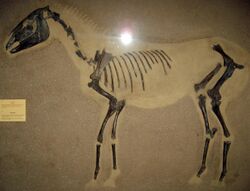
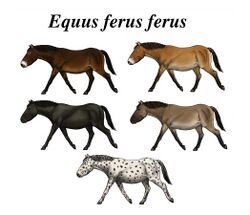
The horse family Equidae and the genus Equus evolved in North America during the Pliocene, before the species migrated across Beringia into the Eastern Hemisphere.[28] Studies using ancient DNA, as well as DNA of recent individuals, suggest the presence of two equine species in Late Pleistocene North America, a caballine species, suggested to be conspecific with the wild horse,[29][30] and Haringtonhippus francisci, the "New World stilt-legged horse"; the latter has been taxonomically assigned to various names, and appears to be outside the grouping containing all extant equines.[31] In South America there appear to have been several species of equine, Equus (Amerhippus) neogeus, which had previously thought to represent 5 taxa due to morphological variability,[32] and several species of Hippidion, which also lie outside the group containing all living horses.[33] (It had previously been suggested to have been nested within Equus based on incomplete sequence data[34])
Currently, three subspecies that lived during recorded human history are recognized.[25] One subspecies is the widespread domestic horse (Equus ferus caballus),[25] as well as two wild subspecies: the recently extinct European wild horse (E. f. ferus) and the endangered Przewalski's horse (E. f. przewalskii).[10][11][25]
Genetically, the pre-domestication horse, E. ferus, and the domesticated horse, E. caballus, form a single homogeneous group (clade) and are genetically indistinguishable from each other.[29][34][35][36] The genetic variation within this clade shows only a limited regional variation, with the notable exception of Przewalski's horse.[29][34][35][36] Przewalski's horse has several unique genetic differences that distinguish it from the other subspecies, including 66 instead of 64 chromosomes,[10][37] unique Y-chromosome gene haplotypes,[38] and unique mtDNA haplotypes.[39][40]
Besides genetic differences, osteological evidence from across the Eurasian wild horse range, based on cranial and metacarpal differences, indicates the presence of only two subspecies in postglacial times, the tarpan and Przewalski's horse.[7][41]
Scientific naming of the species
In some sources including MSW 3 (2005), the domesticated and wild horses were considered a single species, with the valid scientific name for such a single horse species being Equus ferus,[42] although MSW erroneously used E. caballus for this (enlarged) taxon on account of a mis-interpretation of the then-recent ICZN ruling on the matter,[43] refer Groves & Grubb, 2011.[44] The wild tarpan subspecies is E. f. ferus, Przewalski's horse is E. f. przewalskii, while the domesticated horse is nowadays normally (but not exclusively) treated as a separate species E. caballus. The rules for the scientific naming of animal species are determined in the International Code of Zoological Nomenclature, which stipulates that the oldest available valid scientific name is used to name the species.[45] Previously, when taxonomists considered domesticated and wild horse two subspecies of the same species, the valid scientific name was Equus caballus Linnaeus 1758,[46] with the subspecies labeled E. c. caballus (domesticated horse), E. c. ferus Boddaert, 1785 (tarpan) and E. c. przewalskii Poliakov, 1881 (Przewalski's horse).[47] However, in 2003, the International Commission on Zoological Nomenclature decided that the scientific names of the wild species have priority over the scientific names of domesticated species, therefore mandating the use of Equus ferus for both the wild and the domesticated horse if the two taxa are considered conspecific.[48]
Przewalski's horse
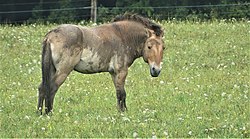
Przewalski's horse occupied the eastern Eurasian Steppes, perhaps from the Urals to Mongolia, although the ancient border between tarpan and Przewalski's distributions has not been clearly defined.[49] Przewalski's horse was limited to Dzungaria and western Mongolia in the same period, and became extinct in the wild during the 1960s, but was reintroduced in the late 1980s to two preserves in Mongolia.[50] Although earlier researchers such as Marija Gimbutas theorized that the horses of the Chalcolithic period were Przewalski's, a 2003 study indicated that the Przewalski's horse is not an ancestor to modern domesticated horses.[51][52] A 2015 study determined that the Przewalski and domesticated horse lineages diverged from a common ancestor about 45,000 years ago.[53]
In 2018, a DNA study revealed that the horses found associated with the Botai culture were Przewalski's horses, raising the question of whether these animals were an isolated population, if extant Przewalski horses today represent feral descendants, or if the domestication attempt at Botai failed. [54] A 2021 study noted that arrowheads were found in conjunction with some Botai horse remains, suggesting these horses were hunted, rather than domesticated, and thus the question remains unresolved.[55]
Przewalski's horse is still found today, though it is an endangered species and for a time was considered extinct in the wild.[40] Roughly 2000 Przewalski's horses are in zoos around the world.[56] A small breeding population has been reintroduced in Mongolia.[57][58] As of 2005, a cooperative venture between the Zoological Society of London and Mongolian scientists has resulted in a population of 248 animals in the wild.[59]
Przewalski's horse has some biological differences from the domestic horse; unlike domesticated horses and the tarpan, which both have 64 chromosomes, Przewalski's horse has 66 chromosomes due to a Robertsonian translocation.[60] However, the offspring of Przewalski and domestic horses are fertile, possessing 65 chromosomes.[61]
Feral horses
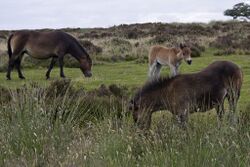
Horses that live in an untamed state but have ancestors that have been domesticated are called "feral horses".[62] For instance, when the Spanish reintroduced the horse to the Americas, beginning in the late 15th century,[63] some horses escaped, forming feral herds; the best-known being the mustang.[64] Similarly, the brumby descended from horses strayed or let loose in Australia by English settlers.[65] Isolated populations of feral horses occur in a number of places, including Bosnia, Croatia, New Zealand, Portugal, Scotland and a number of barrier islands along the Atlantic coast of North America from Sable Island off Nova Scotia, to Cumberland Island, off the coast of Georgia.[66] Even though these are often referred to as "wild" horses, they are not truly "wild" if wildness is defined as having no domesticated ancestors.[62]
In 1995, British and French explorers encountered a new population of horses in the Riwoche Valley of Tibet, unknown to the rest of the world, but apparently used by the local Khamba people.[67] It was speculated that the Riwoche horse might be a relict population of wild horses,[68] but testing did not reveal genetic differences with domesticated horses,[69] which is in line with news reports indicating that they are used as pack and riding animals by the local villagers.[70] These horses only stand 12 h|hh|hh|h}} }} (48 inches, 122 cm) tall and are said to resemble the images known as "horse no 2" depicted in cave paintings alongside images of Przewalski's horse.[69]
See also
References
Citations
- ↑ King, S.R.B.; Boyd, L.; Zimmermann, W.; Kendall, B.E. (2015). "Equus ferus". IUCN Red List of Threatened Species 2015: e.T41763A97204950. doi:10.2305/IUCN.UK.2015-2.RLTS.T41763A45172856.en. https://www.iucnredlist.org/species/41763/97204950. Retrieved 17 February 2022.{{cite iucn}}: error: |doi= / |page= mismatch (help)
- ↑ Grubb, P. (2005). "Order Perissodactyla". in Wilson, D.E.; Reeder, D.M. Mammal Species of the World: A Taxonomic and Geographic Reference (3rd ed.). Johns Hopkins University Press. p. 630–631. ISBN 978-0-8018-8221-0. OCLC 62265494. http://www.departments.bucknell.edu/biology/resources/msw3/browse.asp?id=14100015.
- ↑ "Explore the Database". https://www.mammaldiversity.org/explore.html#species-id=1006123.
- ↑ Tadeusz Jezierski, Zbigniew Jaworski: Das Polnische Konik. Die Neue Brehm-Bücherei Bd. 658, Westarp Wissenschaften, Hohenwarsleben 2008, Script error: No such module "CS1 identifiers".
- ↑ "Tarpan". Britannica. https://www.britannica.com/animal/tarpan. Retrieved 7 March 2023.
- ↑ "The Przewalskii and Tarpan Horses". https://imh.org/exhibits/past/legacy-of-the-horse/przewalskii-and-tarpan-horses/.
- ↑ 7.0 7.1 7.2 Colin Groves, 1986, "The taxonomy, distribution, and adaptations of recent Equids", In Richard H. Meadow and Hans-Peter Uerpmann, eds., Equids in the Ancient World, volume I, pp. 11-65, Wiesbaden: Ludwig Reichert Verlag.
- ↑ Goldman, Jason G.. "10 Things You Didn't Know About Przewalski's Horses" (in en). Scientific American Blog Network. https://blogs.scientificamerican.com/thoughtful-animal/10-things-you-didne28099t-know-about-przewalskie28099s-horses/.
- ↑ "The First Horses: The Przewalskii and Tarpan Horses", The legacy of the horse (International Museum of the Horse), http://www.kyhorsepark.com/museum/history.php?chapter=34, retrieved 2009-02-18
- ↑ 10.0 10.1 10.2 Groves, Colin P. (1994). Boyd, Lee and Katherine A. Houpt. ed. The Przewalski Horse: Morphology, Habitat and Taxonomy. Przewalski's Horse: The History and Biology of an Endangered Species.. Albany, New YorkColin P. Groves: State University of New York Press. http://www.noanswersingenesis.org.au/cg_przewalski_horse.htm.
- ↑ 11.0 11.1 Kavar, Tatjana; Peter Dovč (2008). "Domestication of the horse: Genetic relationships between domestic and wild horses". Livestock Science 116 (1–3): 1–14. doi:10.1016/j.livsci.2008.03.002.
- ↑ Bowling, Ann T.; Anatoly Ruvinsky (2000). "Genetic Aspects of Domestication, Breeds and Their Origin". in Ann T. Bowling. The Genetics of the Horse. CABI Publishing. ISBN 978-0-85199-429-1. https://books.google.com/books?id=ZL3A097IbjsC.
- ↑ "Tarpan or Heck Horse". http://horsehints.org/Breeds/TarpanHeck.htm.
- ↑ "Rare horse breed proves crucial to delicate ecosystem - Features". 2012-06-01. http://www.horsetalk.co.nz/2012/06/01/konik-horses/.
- ↑ "Black Hills Wild Horse Sanctuary". http://www.wildmustangs.com/history-of-the-wild-horse.
- ↑ "The Brumbies – Australian Wild Horses › Wild Horses and Mustangs .com" (in en-US). http://www.wildhorsesandmustangs.com/brumbies-australian-wild-horses/.
- ↑ 17.0 17.1 Naundrup, Pernille Johansen; Svenning, Jens-Christian (2015-07-15). "A Geographic Assessment of the Global Scope for Rewilding with Wild-Living Horses (Equus ferus)" (in en). PLOS ONE 10 (7): e0132359. doi:10.1371/journal.pone.0132359. ISSN 1932-6203. PMID 26177104. Bibcode: 2015PLoSO..1032359N.
- ↑ Kirkpatrick, Jay F.; July 2008, Patricia M. Fazio 24 (24 July 2008). "The Surprising History of America's Wild Horses" (in en). https://www.livescience.com/9589-surprising-history-america-wild-horses.html.
- ↑ Villavicencio, Natalia A.; Corcoran, Derek; Marquet, Pablo A. (2019). "Assessing the Causes Behind the Late Quaternary Extinction of Horses in South America Using Species Distribution Models" (in en). Frontiers in Ecology and Evolution 7. doi:10.3389/fevo.2019.00226. ISSN 2296-701X.
- ↑ Orlando, Ludovic; Male, Dean; Alberdi, Maria Teresa; Prado, Jose Luis; Prieto, Alfredo; Cooper, Alan; Hänni, Catherine (2008-05-01). "Ancient DNA Clarifies the Evolutionary History of American Late Pleistocene Equids" (in en). Journal of Molecular Evolution 66 (5): 533–538. doi:10.1007/s00239-008-9100-x. ISSN 1432-1432. PMID 18398561. Bibcode: 2008JMolE..66..533O. https://doi.org/10.1007/s00239-008-9100-x.
- ↑ Kateryna Slivinska; Grzegorz Kopij (2011). "Diet of the Przewalski's horse Equus przewalskii in the Chernobyl Exclusion Zone". Polish Journal of Ecology 59 (4): 841–847. http://www.pol.j.ecol.cbe-pan.pl/article/ar59_4_19.pdf. Retrieved October 29, 2013.
- ↑ Usukhjargal, Dorj; Henkens, RenéJ H. G.; Boer, Willem F. de; Vos, Anneleen E. W. de; Ras, Erica; Duyne, Caroline van (August 28, 2009). "Wolf Predation Among Reintroduced Przewalski Horses in Hustai National Park, Mongolia". Journal of Wildlife Management 73 (6): 836–843. doi:10.2193/2008-027.
- ↑ Philipps, Dave (May 12, 2018). "Let Mountain Lions Eat Horses". The New York Times. https://www.nytimes.com/2018/05/12/sunday-review/let-mountain-lions-eat-horses.html.
- ↑ "Brown Hyena Research Project - The Spotted Hyena". August 8, 2013. http://www.strandwolf.org/en/spottedhyena.php.
- ↑ 25.0 25.1 25.2 25.3 "Equus caballus". Mammal Species of the World. A Taxonomic and Geographic Reference (3rd ed.). Johns Hopkins University Press. 2005. https://www.departments.bucknell.edu/biology/resources/msw3/browse.asp?id=14100015. Retrieved 2009-02-12.
- ↑ Boulbes, Nicolas; van Asperen, Eline N. (2019). "Biostratigraphy and Palaeoecology of European Equus". Frontiers in Ecology and Evolution 7: 301. doi:10.3389/fevo.2019.00301. ISSN 2296-701X.
- ↑ Pruvost, Melanie; Bellone, Rebecca; Benecke, Norbert; Sandoval-Castellanos, Edson; Cieslak, Michael; Kuznetsova, Tatyana; Morales-Muñiz, Arturo; O'Connor, Terry et al. (15 November 2011). "Genotypes of predomestic horses match phenotypes painted in Paleolithic works of cave art". Proceedings of the National Academy of Sciences 108 (46): 18626–18630. doi:10.1073/pnas.1108982108. PMID 22065780. Bibcode: 2011PNAS..10818626P.
- ↑ "Equus caballus [ISC (horse)"]. http://www.cabi.org/isc/datasheet/119345.
- ↑ 29.0 29.1 29.2 Weinstock, J. (2005). "Evolution, systematics, and phylogeography of Pleistocene horses in the New World: a molecular perspective". PLOS Biology 3 (8): e241. doi:10.1371/journal.pbio.0030241. PMID 15974804.
- ↑ Barrón-Ortiz, Christina I.; Rodrigues, Antonia T.; Theodor, Jessica M.; Kooyman, Brian P.; Yang, Dongya Y.; Speller, Camilla F.; Orlando, Ludovic (17 August 2017). "Cheek tooth morphology and ancient mitochondrial DNA of late Pleistocene horses from the western interior of North America: Implications for the taxonomy of North American Late Pleistocene Equus". PLOS ONE 12 (8): e0183045. doi:10.1371/journal.pone.0183045. PMID 28817644. Bibcode: 2017PLoSO..1283045B.
- ↑ Heintzman, P.D.; Zazula, G.D.; MacPhee, R.D.E; Scott, E.; Cahill, J.A.; McHorse, B.K.; Kapp, J.D.; Stiller, M. et al. (2017). "A new genus of horse from Pleistocene North America". eLife 6. doi:10.7554/eLife.29944. PMID 29182148.
- ↑ Machado, Helena; Avilla, Leonardo (3 July 2019). "The Diversity of South American Equus: Did Size Really Matter?". Frontiers in Ecology and Evolution 7. doi:10.3389/fevo.2019.00235.
- ↑ Der Sarkissian, Clio; Vilstrup, Julia T.; Schubert, Mikkel; Seguin-Orlando, Andaine; Eme, David; Weinstock, Jacobo; Alberdi, Maria Teresa; Martin, Fabiana et al. (March 2015). "Mitochondrial genomes reveal the extinct as an outgroup to all living equids". Biology Letters 11 (3): 20141058. doi:10.1098/rsbl.2014.1058. PMID 25762573.
- ↑ 34.0 34.1 34.2 Orlando, Ludovic; Male, Dean; Alberdi, Maria Teresa; Prado, Jose Luis; Prieto, Alfredo; Cooper, Alan; Hänni, Catherine (9 April 2008). "Ancient DNA Clarifies the Evolutionary History of American Late Pleistocene Equids". Journal of Molecular Evolution 66 (5): 533–538. doi:10.1007/s00239-008-9100-x. PMID 18398561. Bibcode: 2008JMolE..66..533O.
- ↑ 35.0 35.1 Cai, Dawei; Zhuowei Tang; Lu Han; Camilla F. Speller; Dongya Y. Yang; Xiaolin Ma; Jian'en Cao; Hong Zhu et al. (2009). "Ancient DNA provides new insights into the origin of the Chinese domestic horse". Journal of Archaeological Science 36 (3): 835–842. doi:10.1016/j.jas.2008.11.006.
- ↑ 36.0 36.1 Vilà, Carles; Jennifer A. Leonard; Anders Götherström; Stefan Marklund; Kaj Sandberg; Kerstin Lidén; Robert K. Wayne; Hans Ellegren (2001). "Widespread Origins of Domestic Horse Lineages". Science 291 (5503): 474–477. doi:10.1126/science.291.5503.474. PMID 11161199. Bibcode: 2001Sci...291..474V. http://pdfs.semanticscholar.org/5a2e/a78566b4a4b36c77147434c15ecdb086fe28.pdf.
- ↑ Benirschke, Poliakoff K.; N. Malouf; R. J. Low; H. Heck (16 April 1965). "Chromosome Complement: Differences between Equus caballus and Equus przewalskii". Science 148 (3668): 382–383. doi:10.1126/science.148.3668.382. PMID 14261533.
- ↑ Lau, Allison; Lei Peng; Hiroki Goto; Leona Chemnick; Oliver A. Ryder; Kateryna D. Makova (2009). "Horse Domestication and Conservation Genetics of Przewalski's Horse Inferred from Sex Chromosomal and Autosomal Sequences". Mol. Biol. Evol. 26 (1): 199–208. doi:10.1093/molbev/msn239. PMID 18931383.
- ↑ Jansen, Thomas; Forster, Peter; Levine, Marsha A.; Oelke, Hardy; Hurles, Matthew; Renfrew, Colin; Weber, Jürgen; Olek, Klaus (6 August 2002). "Mitochondrial DNA and the origins of the domestic horse". Proceedings of the National Academy of Sciences 99 (16): 10905–10910. doi:10.1073/pnas.152330099. PMID 12130666. Bibcode: 2002PNAS...9910905J.
- ↑ 40.0 40.1 "Equus ferus ssp. przewalskii (Asian Wild Horse, Mongolian Wild Horse, Przewalski's Horse)". IUCN Red List of Threatened Species. https://www.iucnredlist.org/details/7961/0.
- ↑ Eisenmann, Vera (1998). "Quaternary Horses: possible candidates to domestication". The Horse: its domestication, diffusion and role in past communities. Proceedings of the XIII International Congress of Prehistoric and Protohistoric Sciences, Forli, Italia, 8–14 September 1996. 1. ABACO Edizioni. pp. 27–36.
- ↑ Mills, Daniel S.; Nankervis, Kathryn J. (2013-05-20) (in en). Equine Behaviour: Principles and Practice. John Wiley & Sons. ISBN 978-1118708064. https://books.google.com/books?id=54bgCAAAQBAJ&q=domesticated+and+wild+horses+Equus+ferus+same+species&pg=PT50.
- ↑ International Commission on Zoological Nomenclature (2003). "Usage of 17 specific names based on wild species which are pre-dated by or contemporary with those based on domestic animals (Lepidoptera, Osteichthyes, Mammalia): conserved. Opinion 2027 (Case 3010).". Bull. Zool. Nomencl. 60 (1): 81–84.
- ↑ Groves, C.; Grubb, P. (2011). Ungulate Taxonomy. Baltimore, USA: Johns Hopkins University Press. p. 179. Script error: No such module "CS1 identifiers".
- ↑ "Principles of nomenclature of zoological taxa". http://www.insecta.bio.spbu.ru/z/zoo-name.htm.
- ↑ Linnaeus, Carolus (1758). Systema naturae per regna tria naturae :secundum classes, ordines, genera, species, cum characteribus, differentiis, synonymis, locis.. 1 (10th ed.). Holmiae (Laurentii Salvii). p. 73. https://www.biodiversitylibrary.org/page/726976. Retrieved 30 January 2009.
- ↑ Bunzel-Drüke, Margret. "Ecological substitutes for Wild horse and Aurochs". Natur- und Kulturlandschaft, Höxter/Jena 2001, Band 4: 10. http://www.koelner-zoo.de/takhi/PDF/Auerochs_Bunzel.pdf. Retrieved 2017-05-28.
- ↑ Gentry, Anthea; Clutton-Brock, Juliet; Groves, Colin (May 2004). "The naming of wild animal species and their domestic derivates (PDF Download Available)" (in en). Journal of Archaeological Science 31: 645–651. doi:10.1016/j.jas.2003.10.006. https://www.researchgate.net/publication/222518224.
- ↑ Bunker, Emma C.; Watt, James C. Y.; Sun, Zhixin; N.Y.), Metropolitan Museum of Art (New York (2002) (in en). Nomadic Art of the Eastern Eurasian Steppes: The Eugene V. Thaw and Other New York Collections. Metropolitan Museum of Art. ISBN 9780300096880. https://books.google.com/books?id=QR4i-SwdhsoC&q=urals&pg=PA164.
- ↑ WAZA. "Overview : WAZA : World Association of Zoos and Aquariums" (in en). http://www.waza.org/en/site/conservation/waza-conservation-projects/overview/return-of-the-wild-horse-project.
- ↑ Wallner, B.; Brem, G.; Müller, M.; Achmann, R. (2003). "Fixed nucleotide differences on the Y chromosome indicate clear divergence between Equus przewalskii and Equus caballus". Animal Genetics 34 (6): 453–456. doi:10.1046/j.0268-9146.2003.01044.x. PMID 14687077. http://pdfs.semanticscholar.org/80a2/49833d14c3c5ff2702f910100fc3f2c9a48e.pdf.
- ↑ Lindgren, G.; Backström, N.; Swinburne, J.; Hellborg, L.; Einarsson, A.; Sandberg, K.; Cothran, G.; Vilà, C. et al. (2004). "Limited number of patrilines in horse domestication". Nature Genetics 36 (4): 335–336. doi:10.1038/ng1326. PMID 15034578.
- ↑ Der Sarkissian, Clio; Ermini, Luca; Schubert, Mikkel; Yang, Melinda A.; Librado, Pablo; Fumagalli, Matteo; Jónsson, Hákon; Bar-Gal, Gila Kahila et al. (October 2015). "Evolutionary Genomics and Conservation of the Endangered Przewalski's Horse". Current Biology 25 (19): 2577–2583. doi:10.1016/j.cub.2015.08.032.
- ↑ Gaunitz, Charleen; Fages, Antoine; Hanghøj, Kristian; Albrechtsen, Anders; Khan, Naveed; Schubert, Mikkel; Seguin-Orlando, Andaine; Owens, Ivy J. et al. (6 April 2018). "Ancient genomes revisit the ancestry of domestic and Przewalski's horses". Science 360 (6384): 111–114. doi:10.1126/science.aao3297. PMID 29472442. Bibcode: 2018Sci...360..111G.
- ↑ William Timothy Treal Taylor and Christina Isabelle Barrón‑Ortiz: Rethinking the evidence for early horse domestication at Botai. Scientific Reports 11, 2021, S. 7440, doi:10.1038/s41598-021-86832-9
- ↑ Gallagher, Paige Williams , Sean. "The Remarkable Comeback of Przewalski's Horse" (in en). Smithsonian. http://www.smithsonianmag.com/science-nature/remarkable-comeback-przewalski-horse-180961142/.
- ↑ "Przewalski's Horse". si.edu. http://nationalzoo.si.edu/animals/asiatrail/fact-phorse.cfm.
- ↑ "Endangered Przewalski's Horses Back On Russian Steppe". https://www.rferl.org/a/endangered-horses-back-on-russian-steppe/27607786.html.
- ↑ "An extraordinary return from the brink of extinction for worlds last wild horse" ZSL Living Conservation, December 19, 2005.
- ↑ Chowdhary, Bhanu P. (2013-01-22) (in en). Equine Genomics. John Wiley & Sons. ISBN 9781118522127. https://books.google.com/books?id=RK8kRaiAvCYC&q=robertsonian+translocation&pg=PA2139.
- ↑ The American Museum of Natural History When Is a Wild Horse Actually a Feral Horse?
- ↑ 62.0 62.1 "Are There Still Wild Horses?" (in en). http://wonderopolis.org/wonder/are-there-still-wild-horses.
- ↑ Luís, Cristina (2006). "Iberian Origins of New World Horse Breeds". Journal of Heredity 97 (2): 107–113. doi:10.1093/jhered/esj020. PMID 16489143.
- ↑ Rittman, Paul. "Spanish Colonial Horse and the Plains Indian Culture". http://paulrittman.com/Indian%20Culture%20and%20the%20Horse.pdf.
- ↑ Nimmo, D. G.; Miller, K. K. (2007). "Ecological and human dimensions of management of feral horses in Australia: A review". Wildlife Research 34 (5): 408–417. doi:10.1071/WR06102. http://pdfs.semanticscholar.org/8a57/bf826fec75c507e4f767a325b255734ceba7.pdf.
- ↑ "Wildlife". http://cumberlandisland.com/the-island/wildlife/.
- ↑ Simons, Marlise (1995-11-12). "A Stone-Age Horse Still Roams a Tibetan Plateau". The New York Times. ISSN 0362-4331. https://www.nytimes.com/1995/11/12/world/a-stone-age-horse-still-roams-a-tibetan-plateau.html.
- ↑ Dohner, Janet Vorwald (2001). "Equines: Natural History". in Dohner, Janet Vorwald. Historic and Endangered Livestock and Poultry Breeds. Topeka, KS: Yale University Press. pp. 400–401. ISBN 978-0-300-08880-9.
- ↑ 69.0 69.1 Peissel, Michel (2002). Tibet: the secret continent. Macmillan. p. 36. ISBN 9780312309534. https://books.google.com/books?id=6sFWvuBug8IC&q=riwoche%20horse&pg=PA36.
- ↑ Humi, Peter (17 November 1995). "Tibetan discovery is 'horse of a different color'". CNN. http://www-cgi.cnn.com/WORLD/9511/tibet_pony/index.html.
Bibliography
- Equid Specialist Group 1996. Equus ferus. In: IUCN 2006. 2006 IUCN Red List of Threatened Species. <www.iucnredlist.org>. Downloaded on 22 May 2006 from [1][yes|permanent dead link|dead link}}].
- Moelman, P.D. 2002. Equids. Zebras, Asses and Horses. Status Survey and Conservation Action Plan. IUCN/SSC Equid Specialist Group. IUCN, Gland, Switzerland.
- Ronald M. Nowak (1999) (in en), Walker's Mammals of the World (6th ed.), Baltimore: Johns Hopkins University Press, ISBN 0-8018-5789-9
Wikidata ☰ Q27742 entry
 |

